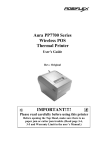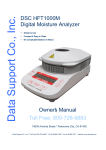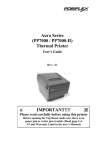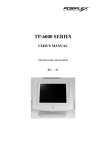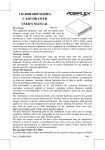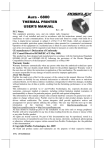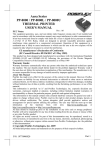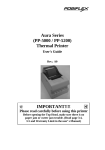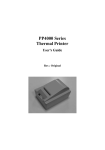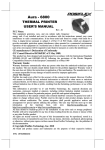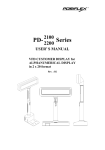Download PYLE Audio PP5600 Printer User Manual
Transcript
PP5600 SERIES POS PRINTER USER’S MANUAL Rev.: A Do not connect cables in ways other than those mentioned in this manual. Different connections may cause equipment damage and burning. Never attempt to repair this product yourself. Improper repair work can be dangerous. Federal Communications Commission Radio Frequency Interference Statement This equipment has been tested and found to comply with the limits for a Class A digital device, pursuant to Part 15 of the FCC Rules. These limits are designed to provide reasonable protection against harmful interference when the equipment is operated in a commercial environment. This equipment generates, uses, and can radiate radio frequency energy and, if not installed and used in accordance with the instruction manual, may cause harmful interference to radio communications. Operation of this equipment in a residential area is likely to cause harmful interference in which case the user will be required to correct the interference at his own expense. For compliance with Federal Noise Interference Standard, this equipment requires a shielded cable. This statement will be applied only for the printers marketed in U.S.A. CE manufacturer’s Declaration of Conformity (EC Council Directive 89/336/EEC of 3 May 1989) This product has been designed and manufactured in accordance with the International Standards EN50081-1/01.92 and EN50082-1/01.92 following the provisions of the Electro Magnetic Compatibility Directive of the European Communities as of May 1989 Warranty Limits Warranty will terminate automatically when the machine is opened by any person other than the authorized technicians. The user should consult his/her dealer for the problem happened. Warranty voids if the user does not follow the instructions in application of this merchandise. The manufacturer is by no means responsible for any damage or hazard caused by improper application. About This Manual This manual is aimed to assist the user to utilize the PP5600 series which is a series of POS printers delicately designed to work with either serial or parallel interface connection. This manual covers both operational and technical aspects. The manufacturer of the PP5600 series heartily apologizes to the user for reserving the right to change or to modify this manual without notice due to the rapid and constant progress and improvement on science and technology. The user may always obtain the most up to date information through our http://www.posiflextw.com, web site: http://www.posiflex.com.tw, http://www.posiflexuk.com or http://www.posiflexusa.com © Copyright Mustek Corp. 2004 All rights are strictly reserved. No part of this documentation may be reproduced, stored in a retrieval system, or transmitted in any form or by any means, electronic, mechanical, photocopying, or otherwise, without the prior written consent of Mustek Corp. the publisher of this documentation. P/N: 19380900020 Table Of Contents BEFORE STARTED . . . . . . . . . . . . . . . . . . . . . . . 1 CONGRATULATION . . . . . . . . . . . . . . . . . . . . . .1 PRODUCT BRIEFING . . . . . . . . . . . . . . . . . . . . . 1 Descriptions . . . . . . . . . . . . . . . . . . . . . . . . . . 1 Features . . . . . . . . . . . . . . . . . . . . . . . . . . . . .1 MODELS . . . . . . . . . . . . . . . . . . . . . . . . . . . . . . . . .1 UNPACKING . . . . . . . . . . . . . . . . . . . . . . . . . . . . . 1 OPTIONS . . . . . . . . . . . . . . . . . . . . . . . . . . . . . . . . 1 IMPORTANT TIPS . . . . . . . . . . . . . . . . . . . . . . . . 1 MAIN PARTS ON THE EXTERIOR . . . . . . . . . 1 INDICATORS . . . . . . . . . . . . . . . . . . . . . . . . . . . . 1 ------------ 1 1 1 1 2 3 3 4 5 6 7 QUICK START-UP . . . . . . . . . . . . . . . . . . . . . . . . 2 -- 1 CONNECTING CABLES . . . . . . . . . . . . . . . . . . . 2 -- 1 Serial connection . . . . . . . . . . . . . . . . . . . . . . 2 -- 1 Parallel connection . . . . . . . . . . . . . . . . . . . . 2 -- 1 Peripheral connection . . . . . . . . . . . . . . . . . . 2 -- 1 Power connection . . . . . . . . . . . . . . . . . . . . . 2 -- 2 LOADING / REPLACING RIBBON CASSETTE . . . . . . . . . . . . . . . . . . . . . . . . . . . . . . . . . . . . . . . . . . . . . . 2 -- 2 LOADING PAPER . . . . . . . . . . . . . . . . . . . . . . . . .2 -- 4 SELF TEST . . . . . . . . . . . . . . . . . . . . . . . . . . . . . . . 2 -- 5 SPECIAL ADJUSTMENTS . . . . . . . . . . . . . . . . .2 -- 6 Paper near end sensor . . . . . . . . . . . . . . . . . .2 -- 6 DIP switch setting . . . . . . . . . . . . . . . . . . . . .2 -- 6 MAINTENANCE GUIDES . . . . . . . . . . . . . . . . . . . . 3 -- 1 MAINTENANCE GUIDE LINES . . . . . . . . . . . . 3 GENERAL CLEANING . . . . . . . . . . . . . . . . . . . .3 TROUBLE SHOOTING . . . . . . . . . . . . . . . . . . . .3 General problems . . . . . . . . . . . . . . . . . . . . . 3 i ----- 1 1 1 1 Printing problems . . . . . . . . . . . . . . . . . . . . .3 -- 2 Paper jam problems . . . . . . . . . . . . . . . . . . . 3 -- 3 Auto cutter problems . . . . . . . . . . . . . . . . . . 3 -- 3 SPECIFICATIONS . . . . . . . . . . . . . . . . . . . . . . . . . . . 4 -- 1 PRINTER . . . . . . . . . . . . . . . . . . . . . . . . . . . . . . . . 4 PAPER . . . . . . . . . . . . . . . . . . . . . . . . . . . . . . . . . . .4 RIBBON CASSETTE . . . . . . . . . . . . . . . . . . . . . . 4 POWER ADAPTOR . . . . . . . . . . . . . . . . . . . . . . . 4 ii ----- 1 1 2 2 I. BEFORE STARTED A. CONGRATULATION You have made a very wise decision by purchasing the easy loading; high performance; high reliability 9 pin dot matrix impact printer Aura PP5600 series of Posiflex products. This series of printers has been elegantly designed for a Point-Of-Sale, kitchen & kiosk application. The manufacturer of this printer not only wishes to take this opportunity to congratulate your smart investment on buying this printer but also likes to express the wishes for your prosperous future by using it. B. PRODUCT BRIEFING 1. DESCRIPTIONS The Aura PP5600 series printer is a stream-lined low profile 40 column 9 pin dot matrix easy loading impact printer designed to fit the Posiflex POS system perfectly well and also for other POS printing applications. The Aura PP5600 series printer serves the stand-alone desktop application. The print mechanism applied in this printer series is remarkably reliable. as well as the wall mount application The Aura PP5600 series utilizes friction type paper feed mechanism and supports two types of interface input in one machine through semi-automatic detection on which type of cable connected. The interfaces are RS232 for serial interface and Centronics mode for parallel interface. Cabinet color is selectable between beige and charcoal. The Aura PP5600 supports an optional guillotine type auto cutter for paper partial cut and a standard manual cut mechanism. 1-1 It even supports some enhancement capability for reminder function to persons around. It can be used to drive a separately purchased kitchen bell for such reminder function in noisy environment. This printer also supports application in different countries of various kinds of power systems by changing the power cord to the power adaptor. The Aura PP 5600 series also supports an optional journal paper roll rewinder when non-carbon copy paper roll is used. 2. Features • Dot matrix 9 pin printer head • Bi-directional printing with logic seeking • Friction type paper feed • 40 columns for 16.9 CPI • Print on ordinary paper or up to 3-fold non-carbon copy paper • DC 24V powered • Selectable parallel or serial (RS232C) interface by detection on cable change and DIP switch settings • 5 character code pages for code range 80h to FFh supported: USA & Europe PC437, PC850, PC860, PC863, PC865 • 15 international character sets of a dozen characters each within code range 20h to 7Fh supported: USA, France, Germany, England, Denmark, Sweden, Italy, Spain, Japan, Norway, Denmark II, Spain II, Latin America, Korea, Croatia • Versatile print function as emphasized underlining set by software print commands printing and • About 20KB input buffer available enabling simultaneous printing and data receiving 1-2 • Supports Posiflex kitchen bell drive when used as kitchen printer • Hardware hand shaking in serial interface through DIP switch selection • Manual paper cut mechanism for PP5600D or guillotine type auto cutter plus manual cut mechanism for PP5600B • Supports ESC command • Dimension: 228 mm (l) x 158 mm (w) x 140 mm (h) C. MODELS PP5600D – with manual cutter PP5600B – with auto cutter PP5600A – with take up rewinder and auto cutter D. UNPACKING Followings are items you may find when you carefully unpack the carton that delivers Aura PP5600 series printer. If there is any discrepancy or problem, contact your dealer immediately. Be sure to save the packing materials in case the printer needs to be shipped at some point in the future. • The printer itself. ‚ Test paper roll 76 mm in width. ƒ Ribbon cartridge „ One of the interface cables: a Serial cable with 9 pin D sub Female to 9 pin D sub Male connectors b Parallel cable with 25 pin D sub Male to 25 pin D sub Female connectors 1-3 Length of the interface cable depends on whether the order includes the power adaptor. When power adaptor is included, the interface cable is 6 ft long for stand alone application. When the power adaptor is not included in the order, the interface cable is a shorter one for integrated application in Posifle x POS system. … One of the power sources: a Power adaptor + power cord (depend on country type ordered). b Power supply cable (when no power adaptor ordered) This printer power supply cable is used to supply power to the printer from the PB or PST series of Posiflex POS system. † This User’s Manual E. OPTIONS The underlined items below must be well defined in order, they can not be field added or changed. • Paper near end sensor • Special language selection • Case color option • Inked ribbon cartridge • Kitchen bell • Guillotine type auto paper cutter • Journal paper roll rewinder • Wall mount kit • Paper roll 1-4 F. IMPORTANT TIPS Place the printer on a sturdy, level surface. Choose a place that is well ventilated and free from direct sunshine and excessive heat, dust, smoke or fume. Never attempt to disassemble or modify this product. Unauthorized interior access voids product warranty. Do not connect a telephone line to the peripheral port. Otherwise, both printer and telephone line may be damaged. Do not touch the print head after printing. It can become very hot. Use a grounded AC power outlet. Use only the power cord and power adaptor furnished with the printer. Do not use a power outlet of a circuit shared with any equipment that causes great electrical noise, such as motors. Do not use a power outlet of a circuit shared with any equipment that uses a lot of power, such as a copier or a coffee maker. Do not set any liquid or drinks such as coffee on the printer case. Do not touch any connector contacts to avoid possible electrostatic damage. Ideal room temperature is from 5ºC to 40ºC. Ideal humidity is from 20% to 85% RH (no condensation). 1-5 G. MAIN PARTS ON THE EXTERIOR Top Cover Manual Cutter Power LED Error LED PP5600B PP5600D Power Switch Parallel Connector Paper Out LED FEED Button Bottom Cover Rear View Power Connector Peripheral Connector Serial Connector Frame Ground Screws Bottom View Setup Window Window Plate Screw 1-6 Interior View Auto Cutter Ribbon Cassette Area Paper Guide Roller Paper Roll Area Lift Tab Indicators • Power LED: green • Error LED: red • Paper Out LED: red 1-7 II. QUICK START-UP A. CONNECTING CABLES 1. Serial connection All the external connectors are in the recessed area at the rear bottom. The serial connector is a 9 pin D sub Female connector at the right in the picture above. Apply the male connector of RS232 cable to this port for serial application. Please note that when serial connection is used, there must be no cable connection at the parallel port on the printer. The default protocol used in serial connection is 9600 bps, none parity check, 8 data bits, 1 stop bit. 2. Parallel connection The parallel connector is a 25 pin D sub Male connector at the leftmost location in the connector area. Apply the female end of the parallel cable at this port for parallel application. Please note that when parallel connection is used, there must be no cable connection at the serial port on the printer. Please also check the DIP switch settings inside the service window at bottom side of the printer following instructions later in this chapter. 3. Peripheral connection The peripheral controller is a RJ11 jack near the serial connector. With use of Posiflex cash drawer cable 20863018001 (CCBLA-180-1), this port can control a Posiflex cash drawer CR3100 or CR3200 or CR4000 or CR4210. If a Posiflex special 2-1 split cable 20867023800 (CCBLA-238) is used instead, this port can control two cash drawers of above models. When the printer is used as a kitchen printer, please use this port for kitchen bell connection instead. 4. Power connection The power connector is a 3 pin jack between the peripheral connector and the parallel connector. Either a Posiflex supplied power adaptor or a printer power cable from a Posiflex POS system can be connected to this connector to supply power for this printer. During insertion of the power plug, be sure to hear the click to obtain a firm contact. CAUTION: Before doing the insertion or extraction of the power plug, be sure to pull the outer sleeve of the plug backward to release the internal latch. Failure to do this could damage the power plug. Such damage is considered as an artificial destruction and is not covered by the warranty. When all the above cable connections are made correctly, you may connect your power adaptor to the wall outlet. Make sure that the type of power cord and the voltage requirement of the power adaptor meet the local power conditions. Do not turn the power on for the moment. 2-2 B. LOADING / REPLACING RIBBON CASSETTE • Turn off the power to the printer. • Lift the front end of the top cover to remove it. • Open the auto cutter by pulling the tab up if it is installed in the printer. Lift (PP5600B) Tab • Remove slack in the ribbon by Fastening turning the ribbon feed knob of the Knob ribbon cartridge counterclockwise. The ribbon must be properly tightened to be able to set in position in installation. Never turn the knob the other way round or the ribbon may mess up inside Pressing this end the cassette and ruin the whole cassette. • If in process of replacing the ribbon cassette, the cassette shall be removed in the manner that the side of the knob is pulled up first with the end of the holding tab Pull up this end to remove Seat this end first remain held down. • Place the ribbon cartridge in position as shown in the picture. Seat the side with the holding tab first then press down the whole cassette. Rotate the ribbon feed knob counterclockwise during the action pressing down the ribbon cartridge into position to help the Ribbon feed knob installation operation if necessary. 2-3 • Turn the knob counterclockwise to remove slack in ribbon for use. • Apply even force to close the auto cutter (PP5600B) so that the small lug of auto cutter Seat lug outside can seat in right position on the bracket below bracket of the print mechanism as in the picture. • Close the top cover by fitting its rear end lug first for ribbon replacement only or go on loadin g paper as in next paragraph. Î š C. LOADING PAPER 1. Drop the paper roll inside the paper compartment in the orientation as shown in left picture below. 2. Cut the leading edge of paper roll perpendicular to paper direction and now please turn on the power to the printer by pressing the power button in front side of the printer. Insert the leading end of the paper roll into the paper intake slot on print mechanism. Insert the paper till you feel the front end caught by the 2-4 3. paper feed roller inside the print mechanism then the paper will automatically advance to proper position (paper exit of print mechanism). In case there was a slip at the insertion of the leading end of paper roll and you want to keep same heading clearance, you may press the FEED button to advance the paper to position. Close the top cover back. Should the front end of paper roll tend to curl as when it comes near end of the paper roll, it is advisable to press the FEED button to check if the paper comes out of the slot in top cover. Engage manual support to make sure it comes out if it fails. D. SELF TEST Press and hold down the feed button while turning on the power. The printer will then perform a self test and print out some major settings detected as in picture at right. You may turn off the power and turn it on again to resume normal use of the printer at this stage. You may also press the feed button at this moment to have the printer further print out some basic font used and a special pattern to have the self test proceedings completed as in the picture on next page. Please note in the first part that both serial and parallel interfaces are indicated. That means the printer is working on an auto-sensing and auto-select algorithm. The pattern of long vertical lines at 2-5 bottom of the slip is an indicator for adjustment on socalled bi-directional printing offset. E. SPECIAL ADJUSTMENTS 1. Paper near end sensor If the paper near end sensor is Fixing Screw installed in the printer and enabled, a fine tuning on the position of the paper near end sensor may be required for different outer diameter of the paper roll bobbin. Please refer to the picture at right from inside the Sensor Head paper roll compartment that there are a fixing screw and a sensor head in the wall. Slightly release the fixing screw using a blade screw driver or suitable coin to adjust the position of sensor head. For smaller roll diameter, the sensor head should go lower. 2. DIP switch setting In setup window on bottom plate of the printer there are 2 DIP switches. The 4 position switch at the right is coded S1 and controls bi-directional print offset. The 8 2-6 position switch at the left is coded S2 for general printer settings. a.Bi-directional printing offset - S1 On Off On Off On Off On Off On Off On Off On Pos. 1 On Off Off On On Off Off On On Off Off On On Pos. 2 Off On On On On Off Off Off Off On On On On Pos. 3 Off Off Off Off Off On On On On On On On On Pos. 4 Value 0 1 2 3 4 5 6 7 8 9 10 11 12 13 14 15 The offset values in above table are in unit of half dot. The bi-directional printing offset actually is well adjusted and requires no further action when a new printer is received. However, after long period of usage some internal mechanical clearance will vary. This clearance can be observed from the offset pattern printed in bottom of self test. Whenever the lower part of the long vertical lines is shifted horizontally away from the upper part by about one dot width, the offset value should be adjusted to move it back for decent print if bi-directional print is engaged. Increasing the offset value by changing the S1 setting can move the lower part to right and decreasing the value moves the lower part to left. Off Off Off Off On Off Off Off Off On Off Off b.Printer general setting – S2 Function ON OFF Switch 2-1 Hand shaking mode X-ON/X-OFF DTR/DSR 2-2 Data bit 7-bit data 8-bit data 2-3 Parity check Parity check No parity check 2-4 Parity selection Even parity Odd parity 2-5 Baud rate (bps) 4800 9600 2-6 Busy on Buffer full Off line or Buffer full Column spacing 2 half dots 3 half dots 2-7 (columns per line) (42 / 35) (40 / 33) 2-8 Print direction Uni-direction Bi-direction 2-7 Positions 1 to 6 of the S2 switch define the communication protocol and handshaking criteria in RS232 interface. They shall always be set to positions 1 to 4 OFF with position 5 set to ON for parallel interface application. Position 7 of S2 alters the horizontal spacing between characters to get different print density on same font format. Position 8 of S2 determines whether to print only in one direction of print head operation or in both directions. All positions of S2 default to OFF when printer delivered. 3. Wall mount application In wall mount application, the paper near end sensor will not have proper operation and it is suggested not to install it. 2-8 III. MAINTENANCE GUIDES A. MAINTENANCE GUIDE LINES Always turn off and disconnect power before start. Please pay attention not to be hurt by any sharp edge of the metal parts when handling the interior of the printer. Do not touch the print head and motor after printing. It can become very hot. Never use benzene, benzine, thinner, trichloroethylene alcohol, or ketone based solvents on the printer’s plastic and rubber components. B. GENERAL CLEANING Please use a soft hair brush or compressed air to clear away any dust or paper scraps accumulation inside the printer. Check also the area of the auto-cutter regularly. C. TROUBLE SHOOTING This section gives solutions to some printer problems you may have. 1. General Problems No LED lights up on control panel when switched on – Make sure that the power supply cables are correctly plugged into the printer, the power adaptor and to the power outlet. Make sure that power is supplied to the power outlet. If the power outlet is controlled by a switch or timer, try use another outlet. 3-1 2. Printing Problems Nothing can be printed with ERROR LED ON – Check the Paper Out LED. If it is ON, most probably the paper roll is not installed or is at or near the end. Install a new paper roll. If the Paper Out LED is OFF, please check for paper jam described in next item. If there is no paper jam and the printer has been printing for quite a period of time, the print head may be overheated. It will usually cool back in few minutes and the printing will resume. If there is no paper jam and the print head is not overheated, turn off the printer and wait for half a minute then turn it back on. If the problem still remains, contact a qualified service person. Nothing can be printed with ERROR LED OFF – Try to run self test according to previous chapter to check if the printer itself works properly. If the self test passes, check the following: a. Check the connection of the interface cable at both the printer and computer ends. Also make sure that this cable meets the specification required for both the printer and the computer and also the settings by software. b. Check the printer data communication settings against the computer. The printer settings can be found easily on the self test print out. If the problem remains or the self test fails, contact your dealer or a qualified service person. Poor printing quality – Contaminants like paper scraps and dusts on the print head or near worn out inked ribbon can lower the print quality drastically. Clean the print head replace the ribbon cassette as required. 3-2 3. Paper Jam Problems Paper is jammed inside the printer – Please follow procedures below. Do not touch the print head and motor after printing. It can become very hot. • Turn off the printer. • Open the top cover after the print head cools down. • Cut the paper roll from the paper intake slot with a pair of scissors. • Open the auto cutter by pulling the tab up if it is installed in the printer. (PP5600B) • Turn the printer power back to on. • Press the FEED switch to forward the paper out of the paper guide. Engage mechanical help like tweezers or manual pull if necessary. • Clean the paper path when necessary. • Reload the paper as instructed in “LOADING PAPER”. If the auto cutter is jammed, you may have difficulty opening the auto cutter. Please first resolve the auto cutter problems per description in next item and then come back to deal with the paper jam. Please also clear away any contaminants accumulated in the cutter track. 4. Auto Cutter Problems If any materials like a staple or paper clip or excessive paper scraps fall into the auto cutter unit, the auto cutter could get stuck. In such case, please open the top cover and find adjustment window in the auto cutter as shown in the picture on top of following page. Please apply a small cross head screw driver to turn the plastic screw in the window and to move the cutter blade along the track and reset it to home position. 3-3 Auto Cutter Adjustment Window To check for home position of the auto cutter, please open the auto cutter and look into the blade slot and the spindle hole as in pictures below. Use proper tool to cut away the paper around auto cutter if it presents obstacle to the actions. Clear away any paper scraps from the auto cutter once it is reset to position. Î Blade Slot š Retract blade from the slot Spindle Hole Î Move spindle down š In case it is the auto cutter that fails to respond to the paper cut command, please contact your dealer or a qualified service person. However, please use manual cutter as a temporary alternative measure before this problem is remedied. 3-4 IV. SPECIFICATIONS A. PRINTER ITEM Printing method Print head configuration Printing direction Effective printing width Printing speed (max.) Paper feed method Paper load method Manual cutter Auto-cutter capability Dot Pitch Paper feed pitch (min.) Paper feed holding force Paper feed speed (max.) Input power type Input voltage Power consumption Dimension (mm) Weight SPECIFICATION Dot matrix impact method 9 pins Bi-directional; logic seeking 59.85 mm 4.0 lines / sec @ 42 columns Friction auto-feed Drop and auto paper feed Saw tooth blade Partial cut (1 point at center left) 0.30 (H) x 0.353 (V) mm 0.176 mm (1/144 inches) Min. 8 N (816 gf) 140 mm / sec DC 24 V + / - 5 % 43 W @ printing 228 (D) x 158 (W) x 140 (H) 1.6 Kg net (1.9 Kg w/ auto cutter) B. PAPER Paper type Paper width Paper roll outer diameter Paper roll inner diameter Paper thickness 1 ply regular roll paper up to 3 ply non-carbon copy roll paper 76 + 0 / - 0.5 mm 82 mm max. 12 + 1 / - 0 mm 70 ~ 100 um for 1 ply, 60 ~ 80 um for 3 plies 4-1 C. RIBBON CASSETTE ITEM RECOMMENDED TYPE COLOR RIBBON MATERIAL RIBBON WIDTH CASSETTE DIMENSION EXPECTED LIFE REQUIREMENT RC200P Purple Nylon 66 13 mm 144.4 (W) x 65 (D) x 26.7 (H) mm 3 million characters D. POWER ADAPTOR ITEM INPUT VOLTAGE INPUT FREQUENCY INPUT CURRENT OUTPUT VOLTAGE OUTPUT POWER STATIC LOAD OUTPUT REGULATION VPP RIPPLE & NOISE MTBF EMI STANDARDS REQUIREMENT 100 V AC ~ 250 V AC 50 ~ 60 HZ 1.5 A MAX. @ 115 V AC + 24 V DC 52 W MAX. 0 A ~ 2.2 A +/-5% 240 mV 30,000 HRS VDE – B, FCC – B, VCCI – B 4-2



























